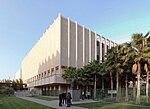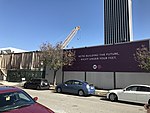Craft Contemporary
1973 establishments in CaliforniaArt museums and galleries in Los AngelesArt museums established in 1973Crafts organizationsFolk art museums and galleries in California ... and 3 more
Gilbert Stanley Underwood buildingsMid-Wilshire, Los AngelesWilshire Boulevard
Craft Contemporary, formerly the Craft and Folk Art Museum, is a non-profit, non-collecting arts museum dedicated to showcasing contemporary craft in Los Angeles, California. The museum is located on Los Angeles' Museum Row on Wilshire Boulevard, and across from the George C. Page Museum and La Brea Tar Pits. It is the only institution on the West Coast of the United States to focus exclusively on craft. In addition to presenting exhibitions, Craft Contemporary is also well-known for its public programs catering to all ages, from family workshops to more intensive sessions for older adults.
Excerpt from the Wikipedia article Craft Contemporary (License: CC BY-SA 3.0, Authors).Craft Contemporary
Wilshire Boulevard, Los Angeles Mid-Wilshire
Geographical coordinates (GPS) Address Nearby Places Show on map
Geographical coordinates (GPS)
| Latitude | Longitude |
|---|---|
| N 34.062222222222 ° | E -118.35555555556 ° |
Address
Wilshire Boulevard 5831
90036 Los Angeles, Mid-Wilshire
California, United States
Open on Google Maps









